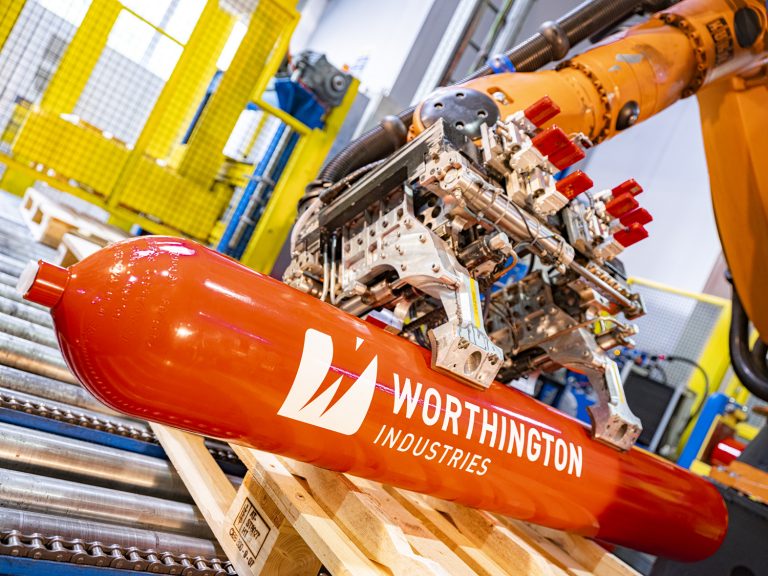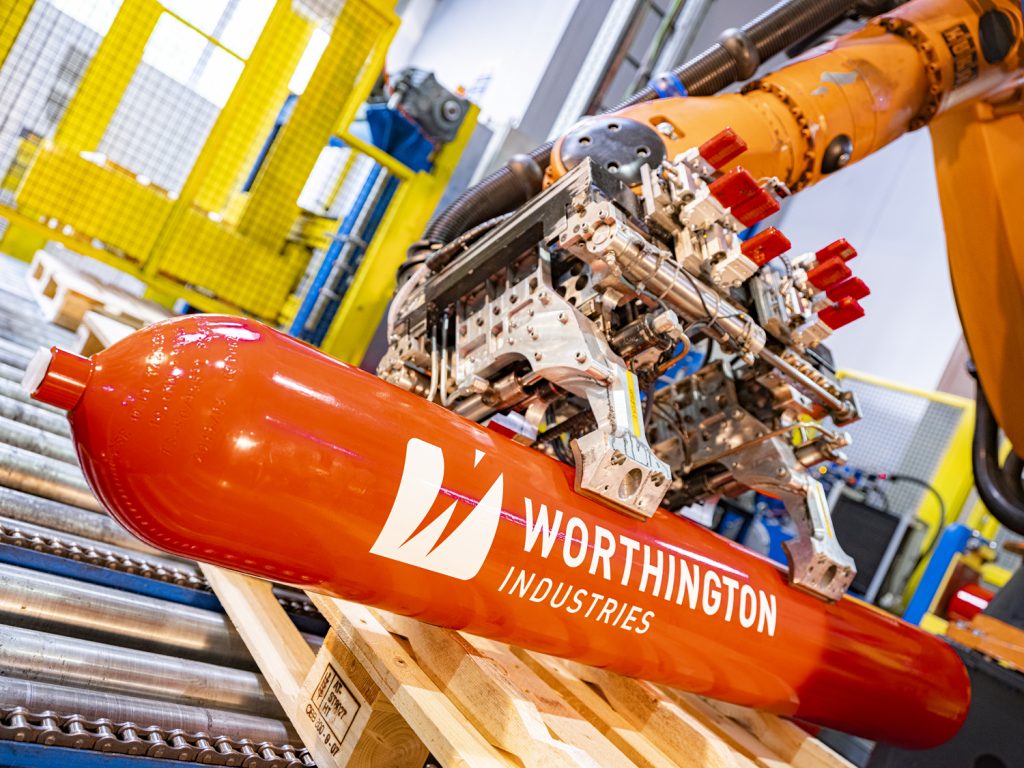Realising the growth divers in packages gases today
Cylinder design and manufacturing technology has evolved dramatically to support new markets and market demands over the years, and diversified metals manufacturing company Worthington has been at the forefront of innovating gas and liquid containment.
Using safety as the foundation of its design and manufacturing processes, Worthington’s pressure cylinders business has grown from humble beginnings as a $2.4m, narrowly focused refrigerant cylinder manufacturer to a global industry leader producing more than 84 million units and $1.2bn in revenue.
The last few years have been a busy period for the Worthington Industries group of companies, with various acquisition and integration activity undertaken, not least the takeover of Portugal-based pressure cylinders manufacturer Amtrol in June 2017.
gasworld caught up with Gabriele Zeilerbauer, Director European Sales – Industrial Products | Alt Fuels Light-Duty Vehicles based in Austria, and Filipe Pedrosa, Vice-President of Sales & Marketing at Amtrol-Alfa, to learn more about the biggest challenges and opportunities that the group sees in the packaged gases business.
For the packaged gases business as a whole, it’s something of a ‘sweet spot’ as Zeilerbauer explains. “This movement is extremely good for both packaged gases and the cylinders business, since pressure cylinders are the most popular form of gas packaging. Due to the weight benefits and higher pressures for hydrogen, manufacturers tend to specify composite cylinders for car, bus and truck onboard fuelling systems.”

“Since Worthington can produce extremely lightweight steel cylinders offering extremely high corrosion protection, our Type I cylinders are also often found in integrated fuelling systems for personal and lightduty vehicles.”
“The real sweet spot for lightweight steel gas packaging is the storage and transport of alternative fuels. Particularly storage, because weight is not a significant factor for a stationary installation – and we are able to offer geometries and working pressures, say up to 400 bar, so that customers get more storage volume per square metre.” With all of this in mind, just how good could it yet prove to be? Zeilerbauer says, “It’s good now, and it can only get better.”
“More and more, people are shaping their lifestyles to reduce their carbon footprint. The ratio of alternative fuel vehicles to vehicles running on conventional fuels will continue to shift in favour of alternative fuels.
“Knowledge sharing through our global network has also helped our colleagues in Portugal introduce Type IV technologies into their key markets – with Fourtis, a fully recyclable type IV LPG cylinder.” Worthington will start the production of Type IV cylinders in Austria by early summer 2020, with Zeilerbauer adding, “Automotive companies are facing tremendous pressure to cut emissions – particularly in Europe. And they are discovering that an all-eggs-one-basket approach will not get them where they need to go. So they are investing in multiple ‘baskets’ – in e-mobility, as well as in hydrogen, hydrogen fuel cells and other alternative fuels.”
“In our new facility, we will produce Type III and IV cylinders along with complete storage, transport and onboard fuelling systems. These new capabilities allow us to support customers making investments in the hydrogen and alternative fuels baskets.”
Industrial gas growth drivers
“We are just as focused on industrial gas customers whose fleets consist primarily of Type I steel cylinders,” Zeilerbauer affirms as our own focus for this interview moves back away from the current buzz for green fuels.
So where’s the growth in industrial gases right now? Pedrosa steps in here and explains that the business climate today is a more complex environment requiring agility and innovation.
“European manufacturers cannot compete on cost alone,” he says. “Room for growth exists where companies are able to pivot from traditional cylinder manufacturing to innovate new service and business models. Even on emerging markets outside Europe, high quality and innovative solutions are appreciated and we’ve been successful in promoting those concepts.”
We learn that one of the big stories for Worthington in 2019 was how it focused and strengthened its sense of purpose, something that is “not easy to do year after year as a global corporation.” This task began with a two-fold question: what problems do Worthington’s customers face, and how can it best solve them?
“Selectively, we play in those markets where we know we can raise the level of the game using traits like drive and curiosity, as well as tools like analytics, technology and digitisation,” explained Zeilerbauer. “Take the alternative fuels market in Europe: we have designed and acquired technologies to cover the evolving ecosystem – from Type I and III cylinder systems for the storage and transport of hydrogen, as well as Type III and IV hydrogen and CNG fuel systems for vehicles that travel on roads, water or rails.”

“As in Europe, our North American products allow customers to meet their sustainability objectives in the alternative fuel space. CNG truck and bus manufactures are choosing our composite cylinders for fuel integration systems,” she adds.
The alternative fuels space is indeed a significant and perhaps obvious area of purpose for Worthington, like so many other companies not just in its field but in the wider gases and technologies industries. “With the growth of hydrogen as a fuel source, customers are also using our composite cylinders for storage applications, high pressure transport trailers and infrastructure projects,” Zeilerbauer enthuses. “In addition, with increased liquid hydrogen production, people in transport logistics rely on our cryogenic trailers for consistent delivery.”
For Worthington, this remains a key area of growth for the company in 2020, as it works to enhance its standing as a leading producer, insights provider, and collaborative partner who can speed the evolution of global infrastructure – and particularly for hydrogen (energy).
People – as private citizens or as professionals – want to use their money in a way that makes good business sense and at the same time is socially and environmentally responsible. This urge is leading to cleaner manufacturing of gases like hydrogen.”
“Soon, we will see a higher density of fuelling stations – both fixed and mobile – for clean fuels. And there will be more clean-fuel vehicles on roads, rail and waterways – even in the air, when we think about the hydrogen drones that are being used for public services like surveying and utilities.”
Worthington is readying itself for this kind of demand, with the expansion of its production capabilities – particularly in Europe – one of its big projects both last year and this.
“Across Europe we have been focusing on becoming better at what we are good at and good at doing new things,” said Zeilerbauer. “For example, our production facility in Pomona, California, allowed us to enter the type IV cylinder market. We are now expanding our Type IV production capabilities in Austria, with the help of our colleagues in Poland.”
Both agree that beyond the alternative fuels movement, there is no simple answer to where the growth lies in the packaged gases business – one has to look beyond just the vessel itself.
“We cannot constrain this question to the vessel itself. We are thinking beyond the cylinder to the environments in which cylinders are situated,” they concur.
“This means asking questions like, what is the market appetite for leasing models that reduce a customer’s annual capex spend? What about smart cylinders and cylinder systems? What potential value chain synergies could we exploit more strategically? How do we integrate physical assets with digital assets? We are working with customers and suppliers to address these questions. If we find smart answers, we will continue to grow in industrial gases.”
The acquisition of Amtrol three years ago was seen as one of the means of Worthington expanding its innovation, described at the time as the coming together of ‘two powerful businesses with robust customer-focused offerings’.

Almost on the eve of the third anniversary of that acquisition, gasworld asked what did Amtrol bring to the group and how has the integration been?
“The acquisition has been mutually beneficial,” Pedrosa says. “Our two organisations have brought two distinct innovation cultures to the table. Worthington places a strong focus on internal process improvement in all areas of the organisation – this has helped us tap new efficiencies in Guimarães.”
“And in turn we bring a long tradition of externally focused, market-driven innovation to a global organisation. As a result, our product designs arise at the intersection of customer insights and our unique development and production set-up.”
He continues, “One reason to celebrate our upcoming three-year anniversary is the CoMet HP. We developed this cylinder – a laser welded liner wrapped in carbon fibre and housed in a polymeric jacket – prior to the acquisition. But since the acquisition, we have been able to work out a more robust production and go-to-market strategy for the product line.”
“Global resources mean we can negotiate with suppliers more effectively, we can optimise the production line, and we can market it in a more targeted manner to key industries like welding and cutting, helium, refrigerants and more.”

